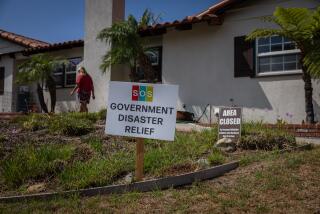Study of Sinking Ground Expands Beyond Edwards : Antelope Valley: A Geological Survey official says the problem is not confined to the air base and that the entire high desert will be examined.
- Share via
A government study of cracking and sinking ground at Edwards Air Force Base, which damaged the dry lake bed the space shuttle lands on, has been expanded to include the entire Antelope Valley, a U.S. Geological Survey official said Friday.
The sinking, caused by pumping ground water from beneath the desert valley, “isn’t just a problem that’s unique to Edwards Air Force Base alone,” said John Klein, district chief of the survey’s water resources division, which is conducting the study for the Air Force.
“There are significant subsidence problems that are beginning to occur in the Lancaster area.”
The Antelope Valley south of Edwards is sinking at an average rate of one inch a year, and the cumulative effect has been a drop of as much as five feet in 50 years, Klein told a meeting in Redondo Beach of the California Water Commission. Sinkage of two to three feet has been recorded at Edwards.
The five-year study was commissioned last year when fissures up to three feet wide, two feet deep and several hundred yards long developed on portions of the 44-square-mile Rogers Dry Lake bed, where the Air Force has several runways. Klein said the damage became so severe that last year the runway had to be quickly reconstructed so the shuttle could land safely.
Subsidence occurs when ground water is pumped from elastic clay beds, and the resulting loss in pressure causes the bed to collapse, the geologist said. Once this happens, the underground storage capacity is lost. “It’s a one-way street beyond a certain point,” said Devin Galloway, a geologist who is coordinating the study at Edwards.
Researchers became aware of the wider scope of the problem when they went south of the base to find a steady ground level against which to measure the subsidence at Edwards. Although geologists had been aware for the past 10 or 15 years that the Antelope Valley was sinking, Galloway said “the magnitude of the subsidence is larger than we expected.”
Klein said the largest level of sinking measured by the government geologists is at Avenue I and Sierra Highway in Lancaster, which according to their estimates has sunk more than five feet over the past 50 years.
“We were pretty shocked to find that,” he said.
Lancaster and Palmdale city officials said they were aware of the problem but not overly concerned.
“We don’t see any immediate emergency situation,” said Jeff Long, director of public works for the city of Lancaster. “It tends to be fairly even and steady, so that tends to not create a severe situation.”
Long said although the city has in the past obtained 50% of its water though ground water pumping, it has steadily increased its reliance on California Aqueduct supplies. Local water district officials estimated that ground water pumping now supplies 40% of the city’s usage.
“That’s a trend we plan to continue,” Long said.
Bill Edgington, a geologist in the Palmdale city engineer’s department, said subsidence is more of a Lancaster problem, and Palmdale developers have not complained of construction problems due to sinking ground. But if extensive ground water pumping continues, he said, the problem could extend to Palmdale in future years.
Klein said that under the natural water flow system, runoff from the San Gabriel and Tehachapi mountains flowed into the Antelope Valley toward the lowest elevation, which was the Rogers Dry Lake bed, where it percolated into the ground. When farms were established, wells were drilled and pumping began for irrigation, withdrawing more water than seeped in.
Consequently, the direction of underground water flow has reversed, and water now flows outward and downward--toward the wells on the valley’s perimeter--instead of collecting beneath the lake bed. The wells have lowered the ground-water level significantly, from 10 feet below the surface in 1948 to a current level of 100 feet below.
More to Read
Sign up for Essential California
The most important California stories and recommendations in your inbox every morning.
You may occasionally receive promotional content from the Los Angeles Times.









